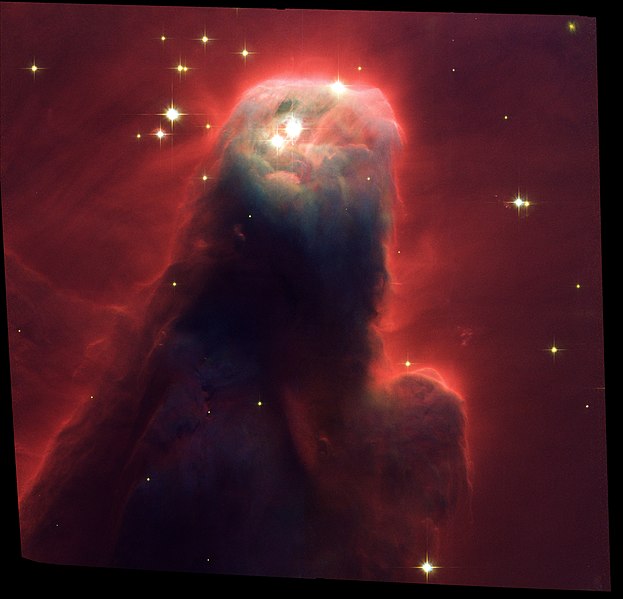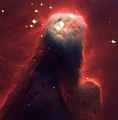| ОписаниеCone Nebula (NGC 2264) Star-Forming Pillar of Gas and Dust.jpg |
summary from the Hubble-site:
English: Resembling a nightmarish beast rearing its head from a crimson sea, this monstrous object is actually an innocuous pillar of gas and dust. Called the Cone Nebula (NGC 2264) — so named because, in ground-based images, it has a conical shape — this giant pillar resides in a turbulent star-forming region. This picture, taken by the newly installed Advanced Camera for Surveys (ACS) aboard NASA's Hubble Space Telescope, shows the upper 2.5 light-years of the nebula, a height that equals 23 million roundtrips to the Moon. The entire nebula is 7 light-years long. The Cone Nebula resides 2,500 light-years away in the constellation Monoceros. Radiation from hot, young stars [located beyond the top of the image] has slowly eroded the nebula over millions of years. Ultraviolet light heats the edges of the dark cloud, releasing gas into the relatively empty region of surrounding space. There, additional ultraviolet radiation causes the hydrogen gas to glow, which produces the red halo of light seen around the pillar. A similar process occurs on a much smaller scale to gas surrounding a single star, forming the bow-shaped arc seen near the upper left side of the Cone. This arc, seen previously with the Hubble telescope, is 65 times larger than the diameter of our solar system. The blue-white light from surrounding stars is reflected by dust. Background stars can be seen peeking through the evaporating tendrils of gas, while the turbulent base is pockmarked with stars reddened by dust. Over time, only the densest regions of the Cone will be left. Inside these regions, stars and planets may form. The Cone Nebula is a cousin of the M16 pillars, which the Hubble telescope imaged in 1995. Monstrous pillars of cold gas, like the Cone and M16, are common in large regions of star birth. Astronomers believe that these pillars are incubators for developing stars. ACS made this observation on April 2, 2002. The color image is constructed from three separate images taken in blue, near-infrared, and hydrogen-alpha filters. Credit: NASA, H. Ford (JHU), G. Illingworth (UCSC/LO), M.Clampin (STScI), G. Hartig (STScI), the ACS Science Team, and ESA The ACS Science Team: H. Ford, G. Illingworth, M. Clampin, G. Hartig, T. Allen, K. Anderson, F. Bartko, N. Benitez, J. Blakeslee, R. Bouwens, T. Broadhurst, R. Brown, C. Burrows, D. Campbell, E. Cheng, N. Cross, P. Feldman, M. Franx, D. Golimowski, C. Gronwall, R. Kimble, J. Krist, M. Lesser, D. Magee, A. Martel, W. J. McCann, G. Meurer, G. Miley, M. Postman, P. Rosati, M. Sirianni, W. Sparks, P. Sullivan, H. Tran, Z. Tsvetanov, R. White, and R. Woodruff.
Español: Sobre un mar carmesí alza su cabeza, este objeto monstruoso es realmente un pilar de gas y polvo inofensivo. Llamada la nebulosa del cono (NGC 2264) - nombrado así porque, en imágenes terrestres, tiene una forma cónica - este pilar gigante reside en una región de formación-estrella turbulenta. Este cuadro, tomado por la cámara fotográfica avanzada nuevamente instalada a bordo para los exámenes (ACS) de la NASA telescopio espacial Hubble, se situa a una distancia superior a 2.5 años luz de la nebulosa, una altura que igual a 23 millones de viajes de ida y vuelta a la luna. La nebulosa entera tiene 7 años luz de largo. La nebulosa del cono reside 2.500 años luz solamente en la constelación Monoceros. La radiación de las estrellas calientes, jóvenes [situadas más allá del borde de la imagen] ha erosionado lentamente la nebulosa sobre millones de años. La luz ultravioleta calienta los bordes de la nube oscura, lanzando el gas en la región relativamente vacía del espacio circundante. Allí, la radiación ultravioleta adicional hace al gas de hidrógeno brillar intensamente, esto produce el halo rojo de la luz alrededor del pilar. Un proceso similar ocurre en una escala mucho más pequeña para proveer de gas al rodear una sola estrella, formando un arco cerca del lado izquierdo superior del cono. Este arco, visto previamente con el telescopio de Hubble, es 65 veces más grande que el diámetro de nuestra Sistema Solar. La luz azul-blanca de las estrellas circundantes es reflejada por el polvo. Las estrellas del fondo pueden ser el mirar a escondidas visto a través de los tendrils que se evaporan del gas, mientras que la base turbulenta es pockmarked con las estrellas enrojecidas por el polvo. En un cierto plazo, solamente las regiones más densas del cono serán dejadas. Dentro de estas regiones, las estrellas y los planetas pueden formar. La nebulosa del cono es un primo del M16, que el telescopio de Hubble reflejado en 1995. Los pilares monstruosos del gas frío, como el cono y el M16, son comunes en regiones grandes del nacimiento de la estrella. Los astrónomos creen que estos pilares son incubadoras para las estrellas que se convierten. ACS hizo esta observación el 2 de abril de 2002. La imagen del color se construye a partir de tres imágenes separadas tomadas en filtros azules, cercano-infrarrojos, y de la hidrógeno-alfa. Del crédito del : NASA, H. Ford (JHU), G. Illingworth (UCSC/LO), M.Clampin (STScI), G. Hartig (STScI), el equipo de la ciencia de ACS, y ESA El equipo de la ciencia de ACS: El H. Ford, G. Illingworth, M. Clampin, G. Hartig, T. Allen, K. Anderson, F. Bartko, N. Benitez, J. Blakeslee, R. Bouwens, T. Broadhurst, marrón del R., C. madriguera, D. Campbell, E. Cheng, cruz del N., P. Feldman, M. Franx, D. Golimowski, C. Gronwall, R. Kimble, J. Krist, M. menos, D. Magee, A. Martel, W.J. McCann, G. Meurer, G. Miley, cartero del M., P. Rosati, M. Sirianni, chispas del W., P. Sullivan, H. Tran, Z. Tsvetanov, blanco del R., y aspérula del R. |
| Автор |
NASA, H. Ford (JHU), G. Illingworth (UCSC/LO), M.Clampin (STScI), G. Hartig (STScI), the ACS Science Team, and ESA
The ACS Science Team: H. Ford, G. Illingworth, M. Clampin, G. Hartig, T. Allen, K. Anderson, F. Bartko, N. Benitez, J. Blakeslee, R. Bouwens, T. Broadhurst, R. Brown, C. Burrows, D. Campbell, E. Cheng, N. Cross, P. Feldman, M. Franx, D. Golimowski, C. Gronwall, R. Kimble, J. Krist, M. Lesser, D. Magee, A. Martel, W. J. McCann, G. Meurer, G. Miley, M. Postman, P. Rosati, M. Sirianni, W. Sparks, P. Sullivan, H. Tran, Z. Tsvetanov, R. White, and R. Woodruff. |






